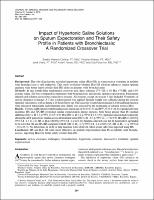Por favor, use este identificador para citar o enlazar este ítem:
https://repositorio.usj.es/handle/123456789/551
| Título : | Impact of Hypertonic Saline Solutions on Sputum Expectoration and Their Safety Profile in Patients with Bronchiectasis: A Randomized Crossover Trial |
| Autor: | Herrero Cortina, Beatriz



Alcaraz-Serrano, Victoria Vilaró, Jordi 


Torres, Antoni 
Polverino, Eva |
| Palabras clave : | Airway clearance techniques; Bronchiectasis; Hypertonic solutions; Mucoactive treatment; Sputum expectoration |
| Fecha de publicación: | 2018 |
| Citación : | Herrero-Cortina, B., Alcaraz, V., Vilaró, J., Torres, A., Polverino, E., 2018. Impact of Hypertonic Saline Solutions on Sputum Expectoration and Their Safety Profile in Patients with Bronchiectasis: A Randomized Crossover Trial. Journal of Aerosol Medicine and Pulmonary Drug Delivery 31, 281–289.. doi:10.1089/jamp.2017.1443 |
| Resumen : | Background:The role of hyaluronic acid plus hypertonic saline (HA+HS) as a mucoactive treatment in patientswith bronchiectasis is still unknown. This study evaluated whether HA+HS solution enhances similar sputumquantity with better safety profile than HS alone in patients with bronchiectasis.Methods:In this double-blind randomized crossover trial, three solutions (7% HS; 0.1% HA+7%HS; and 0.9%isotonic saline, IS) were compared in outpatients with bronchiectasis and chronic sputum expectoration. Participantsinhaled each solution across four consecutive sessions. All sessions, except on session 3, also included 30 minutes ofairway clearance technique. A 7-day washout period was applied. Sputum weight was collected during the sessions(primary outcome) as well as during a 24-hour follow-up. The Leicester Cough Questionnaire (LCQ) and lung functionwere measured before/after each treatment arm. Safety was assessed by the monitoring of adverse events (AEs).Results:Twenty-eight patients with bronchiectasis (mean age of 64.0 (17.9) and FEV1% 60.9 (24.6) of predicted) wererecruited. HS and HA+HS promoted similar expectoration during sessions, both being greater than IS [mediandifference HS vs. IS 3.7 g (95% CI 0.5–6.9); HA+HS vs. IS 3.2 g (95%CI 0.5–5.9)]. Sputum expectorated exclusivelyduring the ACT period was similar across all treatment arms [HS vs. IS-0.3 g (95% CI-1.7to0.9);HA+HS vs. IS 0.0 g(95% CI-1.3to1.4);HSvs.HA+HS 0.0 g (95% CI-1.2 to 0.4)]. Sputum collected over the 24-hour follow-up tendedto be lower for HS and HA+HS compared with IS [HS vs. IS-1.7 g (95% CI-4.2to0.0);HA+HS vs. IS-1.1 g (95%CI-3.6 to 0.7)]. No differences in LCQ or lung function were observed. Most severe AEs were reported using HS.Conclusion:HS and HA+HS were more effective on sputum expectoration than IS in patients with bronchi-ectasis, reporting HA+HS better safety profile than HS |
| URI : | https://repositorio.usj.es/handle/123456789/551 |
| ISSN : | 1941-2711 |
| Aparece en las colecciones: | Artículos de revistas |
Ficheros en este ítem:
| Fichero | Descripción | Tamaño | Formato | |
|---|---|---|---|---|
| Impact of Hypertonic Saline Solutions on Sputum Expectoration and Their Safety Profile in Patients with Bronchiectasis.pdf | 240,22 kB | Adobe PDF |  Visualizar/Abrir |
Este ítem está sujeto a una licencia Creative Commons Licencia Creative Commons

